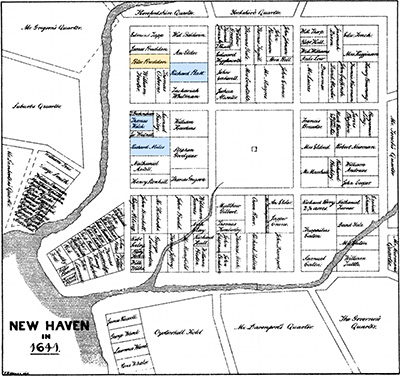Family Tree Updates
Check back monthly for new updates to this family tree!
Paternal Family Line
Maternal Family Lines
Maternal Line By Name
WEBSITE VISITORS
Comments
blog comments powered by Disqus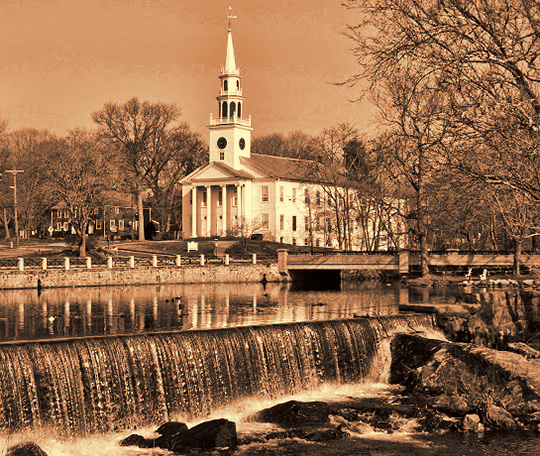
Katherine Elithorpe
8th Great Grandparents of David Pierce Rodriguez
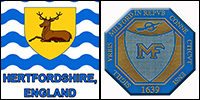 Judge Richard Miles (Myles) II (1598-1666)
Judge Richard Miles (Myles) II (1598-1666)
- Birth: 27 Aug 1598 | Wormley, Great Munden, Hertfordshire, England
- Baptism: 27 Aug 1598 | Great Munden, Hertfordshire, England
- Death: 7 Jan 1666 | New Haven Colony, Connecticut (aged 69 yrs.)
- Burial: New Haven, New Haven County, Connecticut
- Father: Sir Richard Myles I (1563-1628) Great Munden, Hertfordshire, England
- Mother: Alice Cherrye (1576-1628) Great Munden, Hertfordshire, England
- One of the forty-four total Puritan 1639 "Free Planter" Founders of Milford, Connecticut
- Judge in Milford, Connecticut (1639-1640)
- Judge in New Haven, Connecticut (1648-1652)
- Deputy to the New Haven Legislature (1651)
- Clerk of the Artillery Company (1658)
- Deacon
- Marriage to Mary Chambers on 03 Oct 1623 | New Haven, Fairfield, Connecticut Colony
- Marriage to Katherine Elithorpe circa 1638 | New England [Source: U.S., New England Marriages Prior to 1700]
Katherine Elithorpe (1593-1688)
- Birth: Abt. 1593 | Wormley, Great Munden, Hertfordshire, England
- Death: 27 Jan 1688 | At her daughter Anna's house, Wallingford, New Haven, Connecticut (aged abt. 95 yrs.)
- Father: Richard Ellithorpe (1560-1597) Spaulding Moor, Yorkshire, England
- Mother: Isabel Watson (1561-1634) Spaulding Moor, Yorkshire, England
Judge Richard Miles came from Wormela (Wormley) near Warfe Hertfordshire, England with the company that arrived in Boston in 1637.
They had planned to have their own colony, so they went to New Haven in 1638. Some part of them later established Milford, Connecticut and Richard Miles is sixth on list of proprietors (free planters).
His christening record can be found in Great Munden, Hertfordshire, England 1558-1876.
He moved from his birthplace, Great Munden, with his parents to Wormley Co, Hertfordshire, England in 1630. Wormley is six miles South of Ware.
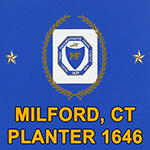
Earliest date of record in New Haven is the Court Record of Freeman (free planter) about 1639.
Excerpt from the Milford Land Records drafted on November 20, 1639:
"William Fowler, Edmond Tappe, Zachariah Whitman, John Astwood, Richard Miles, are chosen for Judges in al civill Affaires who Are to try al causes Between man and man, as a Court to punish any offence and Sin against the Commandments wherein, till A Body of Lawes Shall be Established to observe and Apply them Selves to the rule of the written word of God."
Found briefly in Milford 1640-41, and back to New Haven where he was admitted a member of the General Court 29 Nov 1641. He can be found as one of "five judges of ? affairs." New Haven 1641. General Court 21 Oct 1644 chosen Surveyor of all roads and bridges in 1644. General Court New Haven Colony 22 May 1648 he was chosen Deputy for the Plantation. Deputy to Ct. 1648 and 1649. On the same day he was chosen Clerk, Artillery Co. Judge of New Haven town May 1648-1652. Representative 1651. Deputy (New Haven) to NH Legislature May 1651. NH Colony 1, 381, 382, 456. NH Town 1, 21, 72, 127. Husbandman (farmer). He worked on the first sea-going ship from New Haven, the Phantom Ship, which sank on it's first voyage when many of New Haven's finest died.
Congregational Church, New Haven, New Haven, CT. First Church of Christ records 1639-1926, Vol 1, Milford, New Haven, CT; transferred to the church at New Haven 13 Oct 1639. Dismissed from New York Church. Refered to as Deacon Richard Miles. Served as magistrate, elder and deacon (1656-67) of the First Church of Christ in New Haven (Center Church).
Marriage to Mary Chambers; Marriage records for Great Munden, Hertfordshire, England 1558-1813.
Richard married 2nd to Katharine Elithorpe, widow of Rev. Marmaduke Constable, either before 1638 or 1642, but lists death of unnamed 1st wife as about 1644. [Source: Clarence Almon Torrey and Elizabeth Petty Bently, New England Marriages prior to 1700 (Baltimore: Genealogical Pub. Co., 1985), 508; Google Book; HathiTrust Catalog]
Listed with a family of seven persons in early New Haven. His wife was Mrs. Constable, a widow of Rogers' Company. She was well off, perhaps the widow of Sir William Constable, who's tombstone can be found in Wallingford. [Source: Family Document, Evelyn Miles Krase Notes]
He is listed as being in Milford in 1639, New Haven in 1643, then had seven in his family of which Samuel was baptized at Milford on 12 Apr 1640, being the first in that town; then at New Haven, Hannah, Oct 1642; and John, Oct 1644.
His widow was either a second or third wife, for in the will which was probated 13 June 1667, after providing for his children he gave residue to her, because she had considerable, when he married her, part of which belonged to her children by former husband. [Savage, vol III, p 207]
Richard Miles died on 7 Jan 1667. In his will of 28 Dec 1666, he names his wife Catherine, eldest son Richard, and two other children without name makes division.
Richard & Catherine Miles
The Will Of Judge Richard Miles
 Judge Richard Miles - The emigrant in 1639, was a sharer in the first allotment of land in Stratford, New Haven Colony, and also received house lot No 37, which he later sold to Joseph hawley and acquired a large property in New Milford. He was in New Haven in 1644 an 1652, and a member of the General Court of the New Haven Colony. One of the founders of Milford, CT. in 1639. Resident at New Haven in 1643.
Judge Richard Miles - The emigrant in 1639, was a sharer in the first allotment of land in Stratford, New Haven Colony, and also received house lot No 37, which he later sold to Joseph hawley and acquired a large property in New Milford. He was in New Haven in 1644 an 1652, and a member of the General Court of the New Haven Colony. One of the founders of Milford, CT. in 1639. Resident at New Haven in 1643.
Individual:
From NEHGR, Early New Haven Probate:
Miles, Richard, husbandman. Will made 28 Dec 1666. Bequea ths to eldest son Richard, to rest of children living, and to children of deceased daughter Martha. Estate which came to him through wife Katherine to go to her children in England by a former marriage. Wife Katherine made executrix, and Capt. John Nash, John Cooper, and James Bishop to be overseers.
Witnesses: Roger Alling and Abraham Dowlittle.
Inventory taken 8 Dec 1669, by John Cooper and Richard Alling, £288-06-10£288-06-10
Marriages & Children of Judge Richard Miles II
Marriage 1: Mary Chambers (Abt. 1592) Wormley, Great Munden, Hertfordshire, England
Married: 03 Oct 1623 | Great Munden, Hertfordshire, England
- Francis Miles (24 Jan 1627/1628) | Great Munden, Hertfordshire, Eng
- Richard Miles (20 Oct 1629) | Great Munden, Hertfordshire, England
- Martha Miles (Abt. 1633) | New Haven, New Haven, Connecticut Colony
- Mary Miles (Abt. 1635) | New Haven, New Haven, Connecticut Colony
- Richard Miles (Abt. 1637) | New Haven, New Haven, Connecticut Colony
Marriage 2: Katherine Elithorpe (Abt. 1601) Holme Upon Spalding Moor, Yorkshire, England
Married: Abt. 1638 | New Haven, New Haven, Connecticut Colony
- Samuel Miles (12 Apr 1640) | New Haven, New Haven, Connecticut Colony
- John Miles (1644) | New Haven, New Haven, Connecticut Colony
- Anna Miles (07 Oct 1642 | New Haven, New Haven, Connecticut Colony
History of Wormley, Hertfordshire
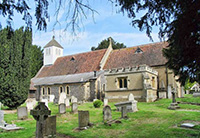 Wormley is a village in Hertfordshire, England. It is within the Borough of Broxbourne. The village is part of the census ward of Wormley and Turnford, which has a population of 8,146 as of the 2001 census.Wormley is located east of the A10 road which links Cambridge to London, commonly known as the Great Cambridge Road. Wormley is sandwiched between Broxbourne and Turnford with a high road of shops.
Wormley is a village in Hertfordshire, England. It is within the Borough of Broxbourne. The village is part of the census ward of Wormley and Turnford, which has a population of 8,146 as of the 2001 census.Wormley is located east of the A10 road which links Cambridge to London, commonly known as the Great Cambridge Road. Wormley is sandwiched between Broxbourne and Turnford with a high road of shops.
The name is thought to derive from the Old English "snake-infested leah"; the last element could mean "clearing", or perhaps "woodland pasture". Wormley was one of the manors which were granted by Harold Godwinson to the canons of Waltham Holy Cross. It was entered in the Domesday Book of 1085 as Wermelai, with a total of 28 households. Wormley remained under the control of the manastry until its dissolution in 1540 when it was granted to Sir Edward North. The manor house called Wormleybury on the south side of Church Lane, was totally rebuilt in 1734 and remodelled in 1767 and 1782 by Robert Mylne for Sir Abraham Hume. It has a stone portico and steps, with an octagonal bell turret. There is interior decoration of 1779 by Robert Adam. It is a Grade I Listed building.
The little Parish Church of St. Lawrence has a nave and font dating from the 12th century. There are several brasses from the 15th century and a marble monument to the Purvy family dated 1617.
The Story Of Milford, Connecticut
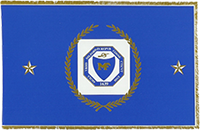 Deeding the land to its new owners was effected with the old English "twig and turf" ceremony. After the customary signing of the deed by both parties, Chief Ansantawae was handed a piece of turf and a twig. Taking the piece of turf in one hand, and the twig in the other, he thrust the twig into the turf, and handed it to the English. In this way he signified that the Indians relinquished all the land specified in the deed and everything growing upon it. The Paugusset Indians sold the Wepawaug land in the hope that they would enlist English protection against the Mohawks, who were continually raiding their territory. Title to the region was based solely on land purchase from the Indians and not upon any grant from the English Crown.
Deeding the land to its new owners was effected with the old English "twig and turf" ceremony. After the customary signing of the deed by both parties, Chief Ansantawae was handed a piece of turf and a twig. Taking the piece of turf in one hand, and the twig in the other, he thrust the twig into the turf, and handed it to the English. In this way he signified that the Indians relinquished all the land specified in the deed and everything growing upon it. The Paugusset Indians sold the Wepawaug land in the hope that they would enlist English protection against the Mohawks, who were continually raiding their territory. Title to the region was based solely on land purchase from the Indians and not upon any grant from the English Crown.
The later purchases of 1655, 1659, 1660, and 1661, rounding out the boundaries of the settlement over a period of six years, were also made directly from Indian possessors, referred to in an Indian eed of 1682. As Isabel M. Calder, in her recent History of the New Haven Colony points out, "The hodge-podge of Indian deeds by which the greater part of the lands of the colony were held would have received no recognition outside of New England, and would never have stood the scrutiny of an English Court of law."
Several months of planning and labor followed the purchase of the Wepawaug land before the settlers took actual possession of their new home. On August 22, 1639, while they were still living in New Haven, those intending to move to Wepawaug met in council in Robert Newman's barn and formed the First Church of Milford.
The organization followed the plan adopted by the New Haven Church that same day. "Seven Pillars" were chosen as the governing body, the idea being derived from the Scripture, "Wisdom hath builded her house, she hath hewn out her seven pillars." The "Seven Pillars" of the Milford Church were Peter Prudden, Zachariah Whitman, William Fowler, John Astwood, Edmund Tapp, Thomas Welch, and Thomas Buckingham. Upon them rested the responsibility of examining and passing upon the qualifications of all members. As part of the ceremony of organization, these men appeared before the council of the church, gave a detailed account of their religious experience, made a profession of faith, and ended by reciting the covenant, written by Rev. Peter Prudden.
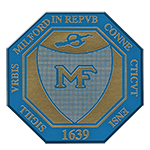
The church was not only a dominating first cause for settlement, but also the controlling force in colonial government, education, and social life. The leaders in the church were the leaders in civil affairs. Except for allegiance to the English Crown, which did not weigh too heavily upon the Fathers, they acknowledged no authority but the word of God, and "combined into a little republic." Their constitution was the Scriptures.
In 1641 a young surveyor of uncommon ability, Robert Treat, was called upon to assist in the laying out of the land. He was destined to become one of the most colorful and prominent figures in the affairs of New Haven Colony and later of Connecticut.
The original grant of homelots sufficed only for the first year or two, while the settlers were occupied clearing the land, building homes and barns, and raising crops. Soon a further division of land was demanded, and twice before 1643 additional grants were made in the outlying sections of the purchase. The original plan of allotting acreage in proportion to a settler's wealth and importance was again followed.
As all of the land was not equally desirable, the lots were "sized" according to value ; if a piece of land were rocky or a long distance from the homelot, the settler who received it was given a larger portion than the man who received a piece of well-watered, easily accessible bottomland. A map of Milford for this period would show the rectangular strips of each man's land-holdings scattered here and there about the settlement.
In this manner, two tracts, called Eastfield and Westfield, lying southeast and southwest of the village center, were allotted. The next division covered other lands south of the homelots and other sections to the north and east. A large tract of meadow, south of Westfield, called the Great Meadow, was also apportioned among the settlers and enclosed by a common fence. Each landowner was compelled to keep up that part of the common fence which bounded his land. Each section was marked with a landowner's initials on an end stake and a penalty of two shillings sixpence was imposed for failure to keep this initialed stake in place. The owner of a section of fence was required to repair any break within sixteen hours or pay a fine of five shillings. Certain designated individuals built and maintained gates instead of a specified footage of fence.
By 1659 tne population had increased to over five hundred, and again there were demands for more land. Robert Treat and Ensign Alexander Bryan negotiated with the Indians for the tract lying between the Indian River and the New Haven line, and extending from the New Haven-Derby path on the north to the Indian path to Oyster River on the south, and purchased it on December 20, 1659, for twenty-six pounds in goods. In 1660 Indian Neck, lying between the Indian River and the Sound, was bought, the Indians reserving twenty acres for planting ground, agreeing "to defend the land, with the swamps, timber, trees, and all the privileges, from the claims of any Indian whatsoever." This twenty-acre reservation was bought from Ansantawae and his son on December 12, 1661, for six coats, three blankets, and three pair of breeches. The town then sold it "by an outcry" for twenty-one pounds six shillings to Thomas Welch, for whom the point was named.
This established Milford's territorial bounds as they are today, with the inclusion of the present town of Orange. The local Indians were granted the right to fish in their old waters, and protection was promised for Chief Ansantawae and his family. Constant disputes over the boundaries of the grants made to the settlers accompanied the rapid division of the land of the community. "Boundary fixers" were in constant demand. To clear up the confusion, in 1646 the first map of the town was made, showing the location of each homelot, the name of the owner, and the number of the lot.
On December 24, 1646, it was ordered by the General Court that every transfer of property, whether by sale, gift, or inheritance, should be recorded in a special book. The fee for recording the transfer was to be twopence, and twopence for a copy of the deed. Two months was the time limit allowed for recording a land transfer, with a fourpence penalty for failure to comply with the law. A report of land transfers was made by the recorder at each meeting of the judges, so that proper tax assessments could be levied. Thus the early court of five judges was not only the first board of selectmen, as the body is known today, but also the first board of assessors.
Communication between Milford and other colonies was usually by way of the old Indian trails. Within the town, instead of first laying out roads, and then apportioning land with reference to the roads, the land was laid out first. The planters then made their own paths or wagon tracks to meet their needs, using Indian trails as much as possible. Broad Street was originally forty rods wide, with the land between it and the harbor left in common as a drill ground for the train band.
In 1646 the Indians went on the warpath and tried to burn down the town by setting fire to the countryside. Fortunately the settlers managed to check the fire at the swamps that lay to the west and north before any damage was done to the palisades, but much valuable timber was destroyed. After this evidence of Indian hostility, sentries were posted along the entire line of palisades. Each household was required to furnish one watchman, who did sentry duty every fifth day. The planters did not venture outside the palisades, except in armed parties. While at work on the farm one of the men would stand guard against a surprise attack. In spite of the hostility of the Indians there is no record of any fatalities in Milford at any time due to Indian attacks. Nevertheless, the whole colony of New Haven lived in constant fear.
In the summer of 1648 the Mohawks, who had been quiet for some time, attacked the Milford Indians in an attempt to capture their fort on the Housatonic River, but were driven off with heavy losses. The story goes that one of the settlers had sighted the invaders hiding in a swamp about a mile from town, and had warned the Milford Indians that the Mohawks were waiting to make a surprise attack on the fort by night. Thus prepared, the Milford Indians were able to meet the Mohawks with such war whoops and volleys of arrows that the enemy fled, leaving behind many dead and several prisoners.
One of these Mohawk captives was tied to a stake on the salt meadows and left to die. He was found unconscious the next morning by Thomas Hine, who released him, fed him, and put him ashore on the other side of the Housatonic River. For this act of mercy the Hine family were ever after venerated and respected by the Mohawks.
It is a tribute to the hardiness of the settlers, and perhaps to the skill of Dr. Jasper Gunn, that there were no deaths in the community for the first five years. The first death, that of Solomon East, the year-old son of William East, occurred on June 18, 1644.
The town was deeply grieved in July, 1656, by the death of its beloved pastor, the Reverend Peter Prudden, at the age of fifty-six. For almost seventeen years he had been the leader and advisor of the little flock. Cotton Mather paid the pastor a tribute which has been inscribed on a tablet, erected in the Church of Christ in Milford by Prudden's descendants. The First Church of Milford remained without a settled pastor from the time of the death of Peter Prudden in 1656 until 1660. The congregation finally agreed upon the Reverend Roger Newton of Farmington, who was "received" July 29, 1660.
The town government kept a regulatory finger upon the tavern and inn, where travelers and their mounts sought accommodation and townsmen gathered of an evening to discuss affairs over a mug of ale. Milford had been without a tavern until June, 1654, when Henry Tomlinson, the weaver, made application to the judges for permission to open an "ordinary." The town was both willing and anxious to grant the request, but neither Tomlinson's house nor its location was suitable for the venture. On West Main Street, then the main road through the town, was a house near the present "Grey Court" apartments owned by Richard Bryan that was better situated for the purpose.
Tomlinson opened the tavern late in 1654, but his innkeeping was not to the satisfaction of the town. He served meagre and unappetizing meals and overcharged his customers. Furthermore, he allowed the young people of the village to congregate there to dance and play cards. In 1655 the town sold the property back to Richard Bryan and William East, with the understanding that they maintain it as a tavern. Since Tomlinson refused to give up the property, claiming it as his own, a court order was necessary before he could be evicted.
Officially, New Haven still had jurisdiction over all the seceding towns and resisted the Connecticut claims to them. The struggle that ensued lasted almost two years. When Robert Treat was elected magistrate from Milford to the New Haven General Court on May 25, 1664, ne refused the office because he was in favor of union with Connecticut. On March 12, 1664, King Charles granted his brother, the Duke of York, all the recently acquired Dutch settlement at New Amsterdam and most of the territory involved in the dispute between Connecticut and New Haven. On July 20, 1664, four royal commissioners with extraordinary powers arrived in Boston to inquire into the affairs of the New England Colonies, threatening their self-government.
New Haven and Branford still held out against the union with Connecticut which would have strengthened both colonies in any resistance to royal encroachments. At this point Milford grew impatient at the delay and, through the efforts of Benjamin Fenn and Robert Treat, severed all ties with the New Haven Colony and united separately with Connecticut. After months of further negotiations between New Haven and Connecticut, the differences of the two colonies were finally adjusted, and on May 11, 1665, New Haven gave up its independence and merged with Connecticut. By this act New Haven abandoned its adherence to the principle of absolute union of church and state. The ecclesiastical character of civil government was modified. Property rather than church membership became the basis on which the franchise was granted.
Sources: Judge Richard Miles & Katherine Elithorpe
- John Insley Coddington and Donald Lines Jacobus (1957), Richard Miles of Hertfordshire, England and New Haven, CT, and his family. The American Genealogist 33:130-137.
- John Insley Coddington and Donald Lines Jacobus (1958), Richard Miles of Hertfordshire, England and NH, CT, and his family (II). The American Genealogist 34: 216.
- Author: John Insley Coddington
Title: Katherine (Elithorpe) (Constable) Miles, Ancestress of Certain Miles and Street Families
Abbrev: Katherine (Elithorpe) (Constable) Miles
Publication: The American Genealogist, 1955, 31:24-29 - Author: James Savage
Title: Genealogical Dictionary of the First Settlers of New England
Abbrev: Genealogical Dictionary
Publication: Originally published 1860-1862. Reprint published Baltimore MD, Genealogical Publishing Co., 1994
Page: 3:206-207 - Title: New England Historical & Genealogical Register
Abbrev: NEHGR
Publication: Boston, MA: New England Historic-Genealogical Society, 1847-
Page: 81:128 Early Probate Records of New Haven - Author: Mary Lovering Holman
Title: Ancestry of Colonel John Harrington Stevens and his wife Frances Helen Miller
Abbrev: Stevens-Miller genealogy
Publication: Concord, NH: 1948
Page: pp. 492-495
Author: Clarence Almon Torrey - Title: New England Marriages Prior to 1700
Abbrev: New England Marriages
Publication: Baltimore MD: Genealogical Publishing Co., 1985 & 1992
Page: p. 177
Text: (___) Constable & Katharine ?Moore (1683, ae 95), m/2 Richard Miles aft 1644? - Author: John Insley Coddington and Donald Lines Jacobus
Title: Richard Miles of Hertfordshire, England and New Haven, Connecticut, and His Family
Abbrev: Richard Miles of Hertfordshire, England
Publication: The American Genealogist, 1957
Page: 33:130
Text: Katherine (Elithorpe) (Constable) Miles, widow of Rev. Marmaduke Constable - Author: John Insley Coddington
Title: Katherine (Elithorpe) (Constable) Miles, Ancestress of Certain Miles and Street Families
Abbrev: Katherine (Elithorpe) (Constable) Miles
Publication: The American Genealogist, 1955, 31:24-29
Text: Katherine was married first, at Everingham, co. York, two miles north of Holme-on-Spalding-Moor, on 17 May 1632, to Rev. Marmaduke Constable, Rector of Everingham, perhaps as his second wife. - Author: Clarence Almon Torrey
Title: New England Marriages Prior to 1700
Abbrev: New England Marriages
Publication: Baltimore MD: Genealogical Publishing Co., 1985 & 1992
Page: p. 508
Text: Richard1 Miles (-1666/7) & 2/wf Catharine (Elithorpe/Spoore?) Constable (-1683?, 1687, ae 95), w Marmaluke; b 1638?, b 1642; New Haven

